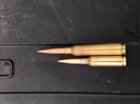They're not available here yet Paul. You can generally reckon on a year, or the best part of it, before newly introduced bullets make it to our importers. Berger promised to get a trial pack of 156 EOLs for me into an existing order being put together for Hannams Reloading, but the shipment hadn't arrived last time I asked.
Depending on the 6.5mm cartridge you shoot, you'll find it difficult to see any practical improvement over your 140gn Hybrid. In practice, how well a bullet groups and holds consistent elevation at long ranges counts for more than typical BC improvements.
However, to model likely changes, let's assume you're getting 2,800 fps MV from the Hybrid, average G7 BC 0.311. It'll move sideways 69.5-inches at 1,000 in a 10 mph true crosswind. Rather more important, that's 6.95 inches per
1 mph equivalent 90-deg change in the wind. As most UK ranges see prevailing quarterly winds, gusts / let-offs are more often than not valued at well under half the actual wind speed change, sometimes a quarter or less.
The 156 EOL will see a lower MV all other things being equal. As the 140 Hybrid / 2800 fps combination produces 2,438 ft/lb ME, the internal ballistic equivalent for a 156 gn bullet is 2,652 fps MV - ie that speed that also produces 2,438 ft/lb ME. So that's the speed to input into the external ballistics program.
Berger quotes average G7 of 0.347 for the 156 EOL. The ballistics program says this BC and 2,652 fps sees lateral movement of 65.51 inches, an improvement of 4-inches for the 10 mph true crosswind change, or 0.4 inches per 1 mph wind change. If the angle is such that half true crosswind applies, that's 0.2 inches per 1 mph, so an actual wind change of 5 mph between shots moves it exactly an inch, or marginally less than 0.1-MOA at 1K. It'll be less with more shallowly angled quartering winds, more with angles nearer 90-degrees.
That inch may make the difference between a marginal five and a four score. However, precision then comes into the equation. At this stage, we're assuming both bullets group equally well at long ranges and hold elevations equally consistently
in your rifle. But say one bullet groups at quarter-MOA and holds quarter-MOA elevation - and the guys and girls shooting 7mm and 300 WSMs in the GB F-Class Association league fixtures get those sorts of values - but the other shoots half-MOA variations in both metrics. The effects of the difference between them heavily outweigh anything from BC change.
So, by all means give higher BC bullets like the EOL a go, but be aware that
practical returns may be less than you think for the extra cost, load development, range time, and effect on barrel life of working a new load up given most 6.5s using stainless have a really high precision life of well under 2,000 rounds.
FWIW, I've found that this Berger bullet to be best in my only remaining L-R 6.5, a Savage PTA based job in 6.5X55mm with a Bartlein barrel:
https://bergerbullets.com/product/6-5-mm-140-grain-long-range-bt-target/
despite a relatively modest BC of 0.304. Because it has a shorter bearing surface than either the 140 Hybrid or 156 EOL it can be driven a little faster than them too before pressure limits are achieved. That's not to say you'd do better with it as it may not outperform your existing Hybrid never mind the 156 EOL, but there are several other fans of this bullet here on the AS Forum.











